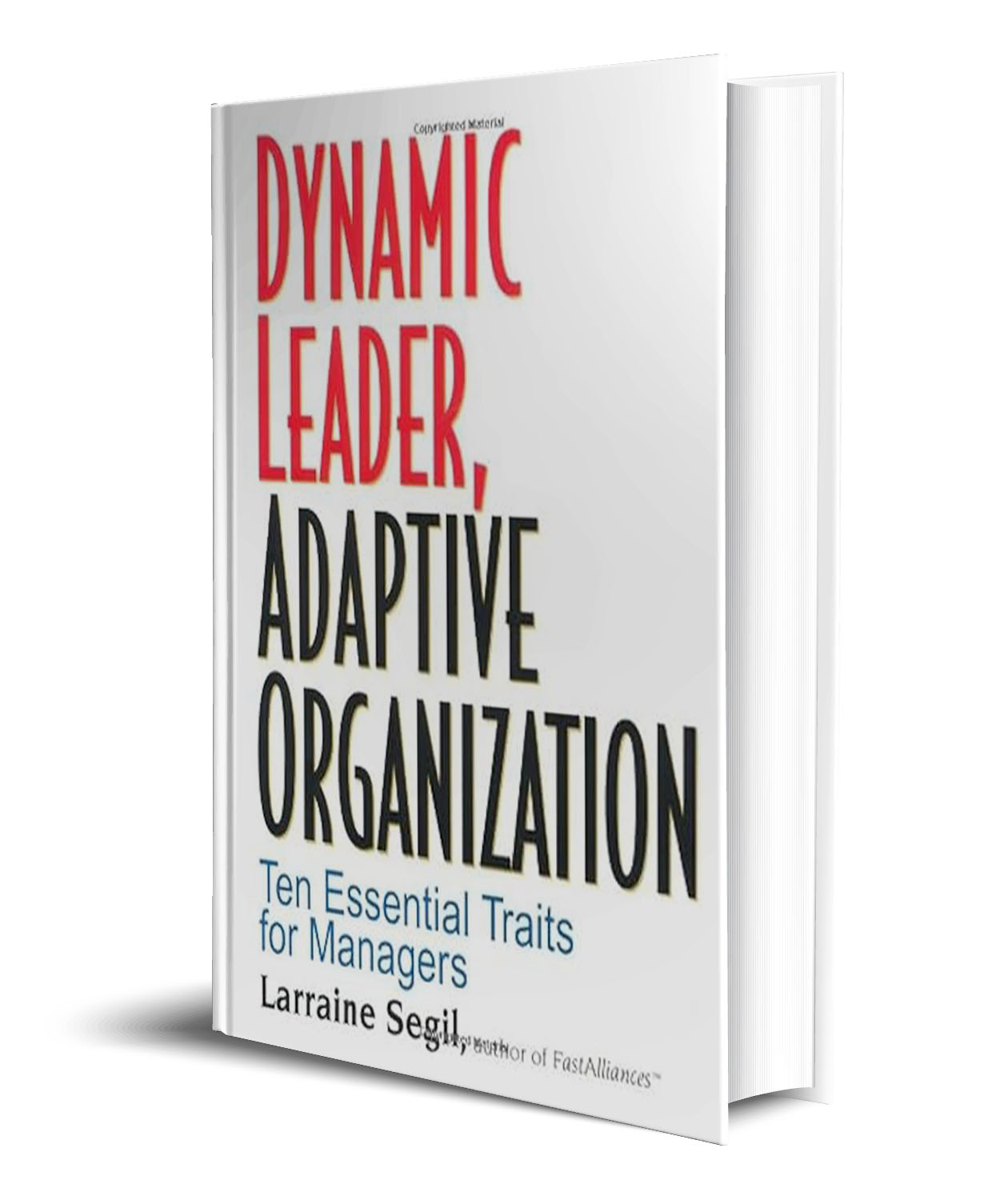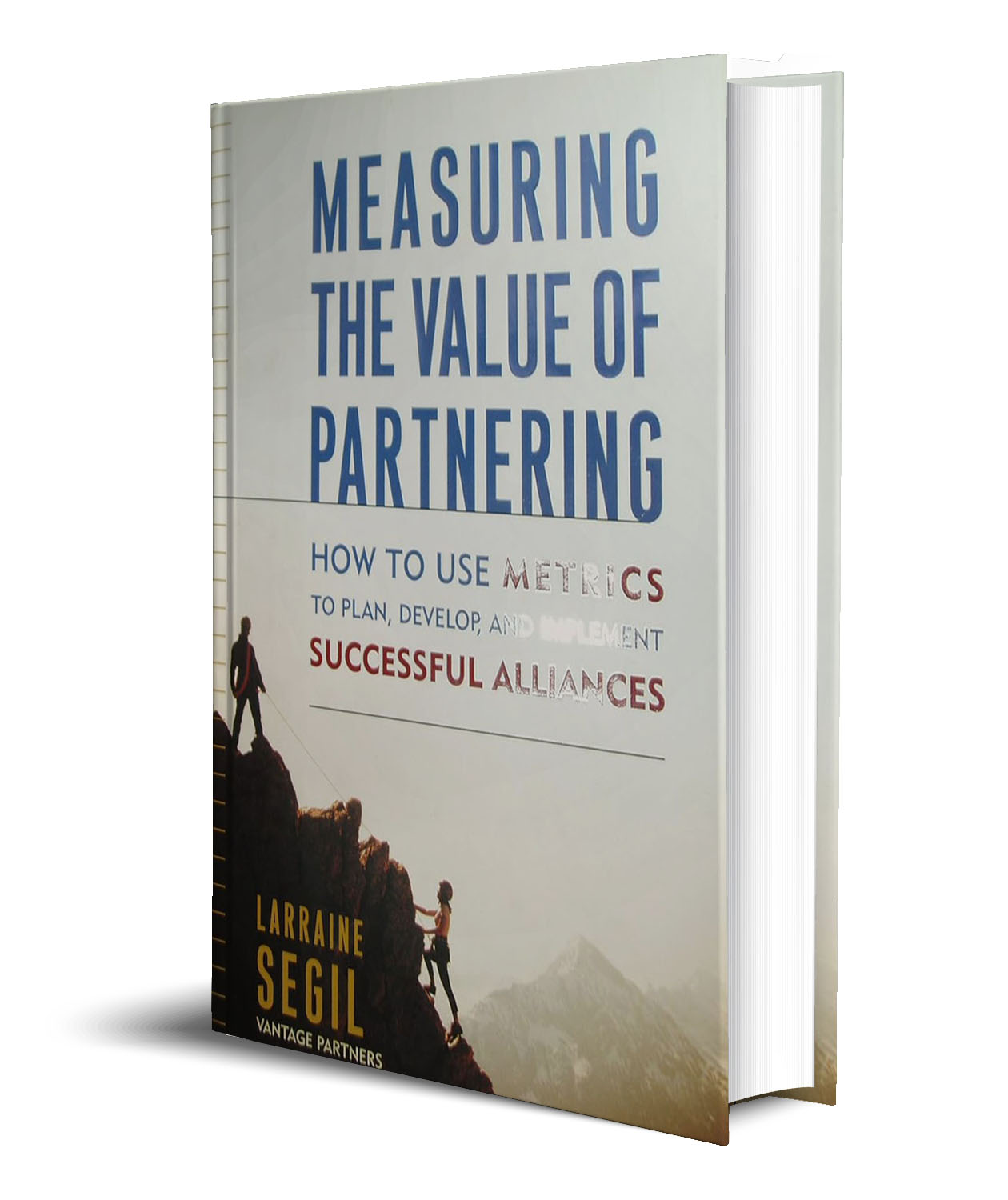Measuring What Matters
Metrics Matter
By Larraine Segil
Financial Executives International, December 2004
It’s an unfortunate fact that 70 percent of alliances fail, yet, ‘going it
alone’ doesn’t make financial sense. Forging successful partnerships is critical
for giving companies a strategic advantage, and the way to ensure they work is
expressed in one word: METRICS.
Do you remember Professional Cleaning Network (PCN)? Probably not. At one time,
PCN was the largest U.S. independent carpet and upholstery cleaning company.
Just eight months after it was acquired by Textrol Acquisition Trust, it was
bankrupt.
Now, consider the pending break-up of the Toys "R" Us Inc./Amazon Inc. alliance.
Heralded as the perfect marriage in the golden dot-com era, both companies have
filed suit to end their 10-year marketing marriage, and Amazon is seeking to
have Toysrus.com pay in excess of $750 million for expected lost revenue, among
other issues. Separately, as reported in the October 25 issue of The Wall Street
Journal, Toys "R" Us is actively seeking a buyer.
Conversely, consider the Hewlett-Packard Co.-Compaq Computer Corp. merger. Given
the myriad challenges and stumbling blocks, there were big questions as to
whether the merger would even take place. It’s now being labeled "a success,"
with HP and Compaq having become – through the merging process – a competitor
far more formidable than either company could have become alone. CEO Carly
Fiorina says HP expects earnings per share to grow by 20 percent for fiscal 2004
and for the next couple of years, and that the company is innovating at the
fastest rate in its 60-year history.
Consider, too, Starbucks Corp. Starbucks has gone way beyond its coffee shops –
once a single source of serving its marketplace. Board a United Airlines flight,
and sit back and enjoy a cup of Starbucks coffee. Walk down the aisle of a
grocery store, and grab a bag of Starbucks coffee. Starbucks has made a big
effort towards partnering with its customers, vendors and distributors, and
having those partner with one another; its growth has undeniably been fueled by
its alliances.
Why have Starbucks’ and HP’s partnerships succeeded when those of PCN/Textrol
Acquisition Trust and Toys "R" Us/Amazon failed?
The answer can be found in one word: metrics.
Once seen primarily as a way to cut costs, alliances now play a strategic role
in increasing revenue, fueling growth and improving efficiency. Because today’s
attractive rates of internal growth are hard to sustain, fluctuating share
prices make acquisition valuations a challenge. In this environment, "going it
alone" does not make sense financially. Strategic alliances are giving companies
a competitive advantage.
Yet, despite their prevalence and importance, most alliances are doomed to fail.
It is a widely accepted fact that the majority (70 percent) of alliances either
fail outright, fall captive to shifting priorities or achieve only initial
goals, and 55 percent fall apart within three years after they are formed.
The leadership of best-practice companies, such as HP and Starbucks, put their
alliances on the right track by applying metrics throughout the life of the
alliance. Be it alliances, mergers, acquisitions, outsourcing contracts or joint
ventures, the goal is to create value, and they know that the only way to ensure
the relationship is creating value is by applying metrics throughout the life of
the alliance – from development through implementation and integration.
These companies understand that financial metrics are but a small portion of the
value that can be developed or lost in a relationship. Unlike transactional
business arrangements between companies, strategic alliances are open-ended,
intimate, long-term, risky and unpredictable. They involve the union of
organizations with different cultures, values, histories, interests and methods
of operating.
In its 2001 study, Managing Alliance
Relationships: A Cross-Industry Study of How to Build and Manage Successful
Alliances, Vantage Partners found that alliances most often fail – not
because of poor strategy and development or business mismanagement – but because
partner companies are unable to work together effectively and are, therefore,
unable to achieve their joint goals.
For this reason, it is imperative that CFOs go beyond negotiating the financial
aspects of the deal and "letting it run," so to speak. They need to set up
metrics for fostering communication, decision-making, problem-solving and
conflict resolution and for evaluating the performance of the relationship over
time. Alliance metrics are divided into two groups: "development" and
"implementation" metrics.
Alliance Development Metrics
Alliance development metrics are most commonly seen even before the alliance is
launched. Remnants of the success factors seen in the development stage will be
seen again during the implementation metrics – all the way from the start-up of
the alliance to its declining stages.
Financial executives certainly know that creating the alliance is the fun part –
where the adrenaline pumps and accolades are given for deal-making. It’s also
the time when future potential of the alliance is plotted, discussed and dreamed
about. Alliances are created for a variety of purposes: to gain a presence in
new markets and product spaces, solve research and development issues or acquire
knowledge and resources more quickly. No matter the purpose, clearly articulated
goals help the partners identify the most useful alliance performance metrics.
Among the key alliance development metrics for partners to address are:
Conceptualization.
This refers to conceptualizing the alliance, creating a vision for it and
determining the potential of what can be accomplished together. For example, a
supplier had been approached by a retailer of huge proportions. In the early
stages of the discussions, the supplier was focused on the potential for growth
in the alliance. It quantified the potential sales, talked a lot about margins,
deliverables and purchase commitments from the buyer.
However, the fundamental vision of the alliance for each party was very
different. The supplier saw the relationship as strategic and long-term, with
real concessions on price on its part, including the need to develop a
customized private-label product for the customer. The buyer saw the
relationship as much more tactical, basically just a purchase agreement enabling
the customer to be competitive in the market as the low-cost provider of
products to consumers. The vision of the relationship for each party was so
divergent that, had this become part of the threshold discussions, each would
have recognized that the alliance would face serious challenges.
Could the issue of incompatible visions be solved? Of course – by discussing the
metrics that were important to each party. The time for discussion, however, was
not at the end of the negotiation process but at the beginning. Why waste
everyone’s time if the margin reductions required by the supplier were not
balanced with the longer term relationship and commitment of trust,
follow-through and relationship-building that would be necessary to sustain such
a relationship?
In this case, the vision discussion would have been able to red-flag an area of
potentially irreconcilable differences, put them on the table for discussion,
and, perhaps, open the door to a different, more mutual type of relationship.
Strategy Alignment. This
means understanding corporate vision and goals. Taking the same illustration
regarding vision as a metric, one of the problems in the development stage of
the partnering process for these companies was that there was little to no
discussion of strategy.
The entire discussion needs to move from the supplier, pricing and volume arena
to the vision and strategic discussion of "How can we both reach the long- and
short-term strategic goals that we have decided, corporately, are part of our
company’s position and future in the market?"
Cisco Systems Inc., the San Jose, Calif.-based networking technology giant,
bases its alliance performance measures on its overall corporate goals, and it
pays close attention to the alliance life cycle. Steve Steinhilber, Cisco’s vice
president, strategic alliances, says Cisco is not as concerned about actual
financials in the first six months of an alliance. So, in the early phases of a
relationship, the company might measure gains in its workforce’s expertise or
the degree of integration that the partners have achieved.
Cisco’s finance department and CFO play a key role in alliance activities –
especially when it comes to metrics that can be used for effective
decision-making and resource allocation. Steinhilber notes that finance helped
develop a three-year return-on-investment (ROI) model that enables the company
to evaluate its alliance investments and compare them with other opportunities,
such as acquisitions and internal development projects. The model incorporates
measures of intangible benefits, including displacement of competitors, expanded
market coverage and acquisition of expertise in vertical markets that are a
priority to Cisco.
The CFO’s contribution made certain that the model included appropriate
threshold returns and risk levels, and established a consistent methodology for
measuring alliance returns. Without a doubt, this model is working. Cisco’s
alliance revenues are growing 12 percent annually and account for more than 14
percent of the company’s total revenues.
Strategic Fit/Corporate Values.
There is no way to overstate the importance of these criteria. Whether the
company is public, private, for- profit or not, its value system is literally
the DNA of the company – its learned and inherited behavior; therefore, it
changes with great difficulty, often only after major trauma and rarely
willingly.
To start looking into the strategic fit of the partner and alliance with similar
corporate DNA, consider the following questions:
o Would the results of the alliance be true to your values?
o Would the potential partner have the same value system?
o How could your company design a reward system for a partner that would be
consistent with your goals?
o How would you establish that the partner truly understands its intent in this
area so that you will not find yourself in a relationship with a partner focused
on different goals?
Each one of the concerns above can become a metric, stated overtly and set up as
part of the evaluation criteria for partners who could be approached or might
approach you. Each could be given quantifiable values so that a numerical
average of partner preference or eligibility could be reached in the early
stages of evaluation.
Pre-launch Development.
The purpose of pre-launch development metrics is to help organize and select the
items that are considered important enough to become part of the measures to
track at this stage of the relationship. While the character and specific nature
of the proposed alliance will determine the nature of this list, suggested items
include:
o Communications protocol: external and internal;
o Reporting and governance: accountability and responsibility;
o Stakeholder changes: to whom is the alliance important now, compared to those
who might have been interested at the relationship’s inception;
o Soft and hard metrics: soft are cultural fit and learning; hard are revenues
generated or research projects in process.
The importance of evaluating soft metrics cannot be over-emphasized. Vantage
Partners’ research into over 235 companies has shown that 75 percent of those
surveyed felt that alliance failure was caused by incompatibility of corporate
culture or personality. The research also found that the business justification
for an alliance is inversely proportional to cultural compatibility. Thus, as
the business justification decreases in importance over time, the cultural
incompatibilities increase in importance. These considerations intersect at
about the three-year time frame – exactly when 55 percent of all alliances fall
apart.
It’s clear that assessing the cultural fit with potential partners has directly
impacted the success of Starbucks’ alliances. CEO Orin Smith says, "When we have
partnered with those we didn’t check out carefully enough, we have made
mistakes. Obviously, nothing is foolproof, but we [spend] an inordinate amount
of time with our potential partners – we get to know their families, their
communities, their business associates – and do very careful due diligence on
all that they have done, before we take the step of agreeing to partner." And,
since Starbucks gets multiple partnering requests every day, he notes, " this is
not a simple process."
Strategic Fit. There
should be significant overlap that occurs between planning the organization’s
overall strategy and planning a strategic alliance. Research has shown that
organizations that think about their alliances in a strategic context (while
considering or reviewing their strategic plans) tend to be far more successful
than those who do not.
In Managing Alliance Relationships, Vantage Partners asked: "Was alignment with
the strategic plan a contributing factor to the success of your alliance? To
what extent (very important, quite important, not important)?" The responses
indicated that alignment with the strategic plan was one of the key success
factors for alliances (very important). The reasons for this are fairly
transparent; the more strategic and integrated into the strategic thinking and
planning of the organization, the more likely it is that the alliance will have
appropriate resources in terms of both human and capital resources.
Often not considered is the fact that strategic fit is a moving target.
Perfectly appropriate partners may become inadequate as a result of internal
changes, external market pressures or the different strategic directions that
either or both partners may take. For this reason, the questions used to assess
strategic fit must be a set of considerations that are visited continually and
updated as conditions require.
Selection.. A fundamental
element of the selection process that is often overlooked is a stakeholder
analysis of all those who will be touched or affected by the alliance as it is
implemented. This is a key issue because: 1) a potential partner may compete
with an existing partner and 2) another division of the company may partner with
a competitor of your selected candidate; that could cause interdivisional
conflict.
Then there is the internal nature of stakeholder analysis, which is to dig out
political landmines that exist in most companies – where people feel their turf
has been invaded or their jobs threatened. This happens often when technology
companies have a professional service component that they offer their customers
and they partner with systems integrators who are all about professional
services.
The key issue is to find out who and where within their own organizations will
there be overlap, how that can be mitigated by making the pie larger for all
parties concerned and whether this anticipated conflict can be headed off at the
pass.
Negotiation. Negotiation
is an essential element of relationship creation and management – ensuring
internal alignment among the various interests of internal stakeholders, as well
as external deal-making and partner development. The negotiation infrastructure
is a process that ensures that parties’ interests are uncovered and
implementation is, as a result, more effective.
The negotiation team should include representatives from corporate divisions,
such as those from legal and finance. Sometimes a person is added to the team
who is considered to be good at negotiating, but who is then removed before
implementation. This is not a good idea because negotiating skills are most
effective when they do not reside in a single individual but rather are seen as
a competency that is critical across an entire organization.
Important to remember is that the modus operandi of the negotiating team (and
the taste that it leaves in everyone’s mouth post-negotiation) will affect the
mood and expectations around the implementation of the relationship. Thus, it is
critical to see negotiation as a part of the continuum of relationship
development, not as a separate activity for those who then have no
responsibility or involvement with the continuing relationship.
A better approach would be for the entire negotiating and implementation team
(including those brought in from the various corporate divisions) to have
negotiation training so that they can view the continuum of relationship
development as part of their mutual responsibilities.
Also important is to measure how the alliance fits within the larger portfolio
of alliances in your organization or division, because that adds perspective to
the present alliance. Seeing a particular alliance as part of a portfolio will
lead to the understanding that some are long- or short-term, some are more
strategic than others, some fill product or technology gaps and others are for
market gaps. This perspective will also give alliance teams, who may be working
on different relationships, a reason to communicate, to share best practices and
to learn collectively from both success and failure.
Alliance Implementation Metrics
This is the process that addresses what happens when the alliance has to start
delivering results. It is important to remember that the nature of these metrics
will change over the life cycle of the alliance.
Among the metrics at this point in the process:
Operationalization. These
metrics relate to the multitude of activities that put flesh around the skeleton
of the alliance. It’s also the moment of hand-off from those who developed and
negotiated the alliance to those who must implement it. Steps to consider during
this stage include:
o Creating the team that is responsible for implementation. The selection must
include not just staff people, but those who have accountability for the
alliance as well as who are responsible for its implementation. The transition
team must contribute to the functional planning, as well as to the financial,
operational, technological and communication protocols and activities that will
make the alliance work. These activities cannot be done in a vacuum, but
socialized with those in the organization who will be affected or touched by the
alliance.
o Ensuring continuity through socialization. This means transferring the
alliance into the culture of the organization. It is part of the buy-in process
– started in the development metrics but continued into the implementation
process. It means a clear statement of what the goals are of the alliance,
communicated with an understanding of potential concerns and contributions of
the audience.
Now is the time to approach the stakeholders (identified in the stakeholder
analysis in the implementation metrics phase) with the information they need to
understand the impact the alliance will have on them and their role in it. It’s
also time to make sure that no roadblocks are put up to prevent alliance
implementation.
o Strategic alignment check. This is part of the hand-off process and a good way
to anticipate any problems that may come up later regarding the provision of
resources to the alliance. As time may have passed since the idea was developed,
it may no longer be as important to each of the partners as it once was. To
determine if it is, answer the following questions:
1. Do you have the same executive sponsor in place, or do you need to find a new
one? Has the executive sponsor changed for your partner?
2. Is this alliance still in line with the strategic intent and fit of the
companies?
3. Have the partner’s attention and focus moved elsewhere?
4. What’s the impact on allocating resources for this relationship?
5. Are the resources coming from the business unit? Or from corporate
headquarters? If so, whose budget is it coming out of? If there are partial
contributions, where and when are they being made?
6. What is the reporting structure? Is it clear to the alliance team? Is it
clear who is reporting to whom and is there a difference between accountability
and responsibility?
7. What is the communication protocol for the alliance?
Change in Mutuality. This
means that are you measuring the benefit in the alliance to your partner (as
well as to yourself). This measurement is critical because reduction in the
benefit to either partner will be a leading indicator of alliance failure. If
you are not measuring it, you will not see this until the failure process is
already in place. When you make mutuality a metric, you give yourself and your
partner the best opportunity to discover problems before they dissolve trust and
create conflict.
To do this, set a quantitative baseline for the issue of mutuality. Then,
measure the level of agreement at the relationship inception by noting the
significant terms of the agreement at varying times during the implementation
process and the percentage of fulfillment responsibility for each term.
Portfolio Management of
Alliances. Seeing your alliance as part of a portfolio will lead to the
understanding that some are long- or short- term, some are more strategic than
others, some fill product or technology gaps and others are for market gaps.
This perspective will also give alliance teams, who may be working on different
relationships, a reason to communicate, share best practices and to learn
collectively from success and failure. Basically, it is a way to realize that
even though the alliance may or may not be reaching or exceeding its goals, it
is part of a portfolio, and that even alliance competency sometimes cannot save
an alliance that is failing.
IBM places great emphasis on the management and implementation of an alliance,
and any alliance has to have a strategic fit with the overall IBM strategy. In
order to make this assessment, the alliance team puts in additional measurements
enabling it to constantly review the program and resolve nonaligned issues.
This is probably one of the most important and critical metrics that has led to
IBM’s success in this area. As such, it asks three key questions that help it
assess the fit (both current and future) of potential partners within the
overall portfolio of alliances:
1.) How do you know if you have the right partners? 2.) How do you keep the
partnering portfolio fresh and timely? 3.) What is the right positioning of the
partners for both the present and the future?
Restructure. Restructuring
an alliance is not that different from restructuring an organization – changes
need to be made in order to improve efficiency, costs or growth. The process for
restructuring an alliance will depend largely on whether continuing with
particular partners is seen as the right thing to do – strategic or tactical,
economically viable or pre-emptive – in that it cannot afford to be terminated
because the partners know too much about each other’s business or, in some
cases, one partner has become so knowledgeable about the other’s business that
it could effectively compete with the other.
Restructuring metrics can include:
* Return on labor hours worked. In a
world of globalization where companies can provide outsourced labor that is
highly skilled and competent at a fraction of the cost, it is becoming important
to evaluate alliances that are labor-intensive, such as research, development,
manufacturing and more, from the point of view of return on labor hours worked.
This also becomes a basis for one of many arguments for or against outsourcing
the activity.
* Return on marketing opportunity cost.
The cost of doing the relationship. The alliance ties up resources for other
activities, so the return received must at least equal the market opportunity
cost, and should exceed it.
* Return on intellectual property invested.
Whatever intellectual property is invested into this relationship should have
given at least the same return that would have been received had it been
invested elsewhere.
While you may determine that some alliances need to be restructured, re-launched
or even re-negotiated (for these, the same metrics for the initial launch and
negotiation can be used, but with more insight), others may need to be
terminated. Once again, the CFO can – and should – play a pivotal role, using
metrics to create an exit strategy.
Without specific measurements in place, partners are limited in their ability to
point to a breach in the relationship if one arises. And if termination is
premature and not according to the expectations of the parties, it can be a
painful process, as in the divestiture or break-up of an acquisition.
Strategic alliances have become an increasingly important component of an
organization’s overall growth strategy because they enable the company to
achieve a variety of goals that would otherwise require years of effort and
considerable expense. At the same time, savvy organizations are realizing that
alliances do not automatically succeed or create value. Creating the alliance is
the easy part; managing it and measuring its success is much more challenging.
For this reason, a growing number of CFOs are taking a proactive role in
developing appropriate metrics to quantify the financial performance of the
alliance, as well as its strategic value, operational effectiveness and overall
quality of the relationship.
This last measurement is critical because metrics should not be totally
quantitative and financially oriented. In fact, an over-reliance on financial
metrics is shortsighted – perhaps positioning the alliance more for failure than
for success.
Alliance Development Metrics
Conceptualization
Strategy Alignment
Development
Strategic Fit
Planning
Selection
Structuring
Negotiation
Team Selection test
Alliance Implementation Metrics
Operationalization
Implementation
Remediation
Restructuring
Re-evaluation
Re-launch
Termination






Leave a Reply
You must be logged in to post a comment.